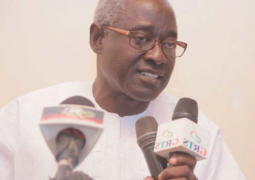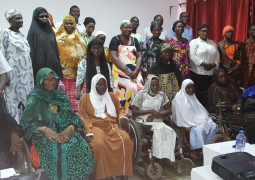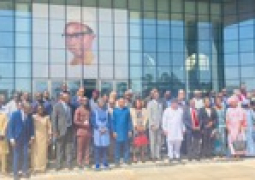
Dr Lamin Dibba made these remarks recently during a site visit to Sapu Agricultural Station, where the institute is jointly conducting a screening of Korean high yielding improved rice variety in collaboration with the KAFACI.
KAFACI is an inter-governmental and multi-lateral cooperation body aimed at improving food production, thus accelerating the development of a new generation productive and stress-tolerant rice varieties.
In 2022, NARI and KAFACI started the partnership, which resulted in the signing of Memorandum of Understanding (MOU) between the two institutions, aimed at assisting the country in meeting her food sufficiency drive. Since then, KAFACI has been assisting the institute with high improved rice varieties.
“In 2022, they assisted NARI with 100 ‘Tongil’ improved rice varieties, a Korean word referring to high yielding rice variety,” he said.“They also supported us with 100 lines and we call it lines because we are still on the screening process. It is at the end of the screening process that you will be able to know whether that particular rice variety is adapted to our own local condition then we can give it a local name and we have not gotten to that stage.”
Of the first 100 lines given to NARI last year, Dr Dibba disclosed that they were able to conduct a screening through a methodology referred to as ‘participatory varietal selection’ where farmers played a key role.
“This is because in the research that we are doing, farmers are also important. That’s why we call some farmers to do the screening together,” he said. “As a researcher you can look at a particular rice variety and would look at certain characteristics that would really impress you and would want those characteristics to go the farmers. But if the farmer looked at the same variety, maybe he or she would look at it from a different angle.”
‘This is the reason participatory varietal selection is crucial as at the end of the screening,’ he said, adding, it is not the researcher who would go and work on those varieties, but the final end product, who are the farmers.
Director Dibba revealed that out of those 100 lines, they were able to identify 57 rice varieties, which was later reduced to about 9 rice lines.
Dr Dibba, however, clarified that not every rice variety could be selected and that those that are not selected are not thrown away; rather they’re shelved, as sometimes they are brought to the fields, where good trades could come out.
“At the end of all this evaluation, we will select about no more than five that will be released officially in our catalogue,” he said.“So currently, we have already shelved 9 rice lines from the 100 lines we received from KAFACI.”
In addition, he stated that towards the end of last year, KAFACI project also assisted the institute with 160 rice varieties, which also underwent similar participatory varietal selection screening involving farmers.
“After the selection process, 17 rice lines were selected and these lines have different attributes and characteristics, which would also follow similar process till the end of the screening process,” he explained.
Dr Dibba indicated that other evaluations would follow later to look at other characteristics before the end of the evaluation.
Hawa Manneh, a technician responsible for lowlands farms at Sapu, disclosed that earlier on they received 160 high improved rice varieties from KAFACI, after which farmers were invited to do a screening.
Out of this, Manneh noted that 17 plus one local variety were selected, which were later replicated on their trial farms.
She also talked about the different stages conducted from transplanting process to fertilizer applications, acknowledging farmers for their efforts.
Read Other Articles In Headlines





